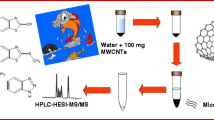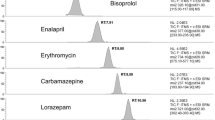Abstract
This is the first report on the analytical application of multiwalled carbon nanotubes (MWCNTs) as solid-phase extraction (SPE) sorbents for determination in surface waters, at the nanograms per litre level, of perfluorooctanoic acid (PFOA) and perfluorooctane sulfonate (PFOS), the two predominant contaminants among the perfluorinated compounds detected. After the preconcentration step, the quantification was achieved by ultraperformance liquid chromatography–electrospray ionization mass spectrometry. To increase the extraction efficiency towards these amphiphilic compounds, MWCNTs were derivatized with amino-terminated alkyl chains, thus producing a mixed-mode material (MWCNT-R-NH2) combining hydrophobic affinity and anion-exchange properties. Experiments with distilled, tap and river water (pH 3) spiked at different concentrations (10, 15, 30, 100, 200 and 500 ng L-1) provided absolute recoveries in the range 71–102 % (n = 3, relative standard deviations less than 10 %). Analytes were eluted in a single fraction with 6 mL methanol (3 × 10-4 M NaOH). The within-laboratory reproducibility of the MWCNT-R-NH2 SPE sorbent was evaluated with raw river water, and relative standard deviations less than 15 % were obtained (n = 4). Preconcentration factors up to 125 (500-mL sample) made it possible to quantify PFOA and PFOS at low nanograms per litre levels in naturally contaminated river water. The method quantification limits of 10 ng L-1 for PFOA and 15 ng L-1 for PFOS were well below the advisory levels for drinking and surface waters. Comparison with non-derivatized MWCNTs highlighted the role of functionalization in improving the adsorption affinity towards these contaminants. MWCNT-R-NH2 maintained their extraction capability for at least eight repeated adsorption/desorption cycles.

Similar content being viewed by others
Abbreviations
- CNT:
-
Carbon nanotube
- EQS:
-
Environmental quality standard
- ESI:
-
Electrospray ionization
- GC:
-
Gas chromatography
- HLB:
-
Hydrophilic–lipophilic balanced
- LC:
-
Liquid chromatography
- MDL:
-
Method detection limit
- MQL:
-
Method quantification limit
- MS:
-
Mass spectrometry
- MS/MS:
-
Tandem mass spectrometry
- MWCNT:
-
Multiwalled carbon nanotube
- PFC:
-
Perfluorinated compound
- PFOA:
-
Perfluorooctanoic acid
- PFOS:
-
Perfluorooctane sulfonate
- MWCNT-R-NH2 :
-
Amino-terminated alkyl-functionalized multi-walled carbon nanotubes
- RSD:
-
Relative standard deviation
- SIM:
-
Selected ion monitoring
- SPE:
-
Solid-phase extraction
- SRM:
-
Selected reaction monitoring
- UPLC:
-
Ultraperformance liquid chromatography
- WAX:
-
Weak anion exchange
References
Herrera-Herrera AV, Gonzalez-Curbelo MA, Hernandez-Borges J, Rodríguez-Delgado MA (2012) Carbon nanotubes applications in separation science: a review. Anal Chim Acta 734:1–30
Hussain CM, Saridara C, Mitra S (2011) Altering the polarity of self-assembled carbon nanotubes stationary phase via covalent functionalization. RSC Adv 1:685–689
Zhao L, Ai P, Duan AH, Yuan LM (2011) Single-walled carbon nanotubes for improved enantioseparations on a chiral ionic liquid stationary phase in GC. Anal Bioanal Chem 399:143–147
Speltini A, Merli D, Dondi D, Paganini G, Profumo A (2012) Improving selectivity in gas chromatography by using chemically modified multi-walled carbon nanotubes as stationary phase. Anal Bioanal Chem 403:1157–1165
Speltini A, Merli D, Profumo A (2013) Analytical application of carbon nanotubes, fullerenes and nanodiamonds in nanomaterials-based chromatographic stationary phases: a review. Anal Chim Acta 783:1–16
André C, Lenancker G, Guillaume YC (2012) Non-covalent functionalisation of monolithic silica for the development of carbon nanotube HPLC stationary phases. Talanta 99:580–585
Speltini A, Merli D, Dondi D, Milanese C, Galinetto P, Bozzetti C, Profumo A (2013) Radiation-induced grafting of carbon nanotubes on HPLC silica microspheres: theoretical and practical aspects. Analyst 138:3778–3785
Li Q, Wang X, Yuan D (2009) Solid-phase extraction of polar organophosphorous pesticides from aqueous samples with oxidized carbon nanotubes. J Environ Monit 11:439–444
Salam MA, Burk R (2008) Novel application of modified multiwalled carbon nanotubes as a solid phase extraction adsorbent for the determination of polyhalogenated organic pollutants in aqueous solution. Anal Bioanal Chem 390:2159–2170
Onghena M, Moliner-Martinez Y, Picó Y, Campíns-Falcó P, Barceló D (2012) Analysis of 18 perfluorinated compounds in river waters: comparison of high performance liquid chromatography–tandem mass spectrometry, ultra-high-performance liquid chromatography–tandem mass spectrometry and capillary liquid chromatography–mass spectrometry. J Chromatogr A 1244:88–97
Post GB, Cohn PD, Cooper KR (2012) Perfluorooctanoic acid (PFOA), an emerging drinking water contaminant: a critical review of recent literature. Environ Res 116:93–117
Loos R, Wollgast J, Huber T, Hanke G (2007) Polar herbicides, pharmaceutical products, perfluorooctanesulfonate (PFOS), perfluorooctanoate (PFOA), and nonylphenol and its carboxylates and ethoxylates in surface and tap waters around Lake Maggiore in Northern Italy. Anal Bioanal Chem 387:1469–1478
Henry ND, Fair PA (2013) Comparison of in vitro cytotoxicity, estrogenicity and anti-estrogenicity of triclosan, perfluorooctane sulfonate and perfluorooctanoic acid. J Appl Toxicol 33:265–272
Hansen KJ, Johnson HO, Eldridge JS, Butenhoff JL, Dick LA (2002) Quantitative characterization of trace levels of PFOS and PFOA in the Tennessee river. Environ Sci Technol 36:1681–1685
Dufková V, Čabala R, Ševčík V (2012) Determination of C5–C12 perfluoroalkyl carboxylic acids in river water samples in the Czech Republic by GC–MS after SPE preconcentration. Chemosphere 87:463–469
Sinclair E, Kannan K (2006) Mass loading and fate of perfluoroalkyl surfactants in wastewater treatment plants. Environ Sci Technol 40:1408–1414
Yamashita N, Kannan K, Taniyasu S, Horii Y, Petrick G, Gamo T (2005) A global survey of perfluorinated acids in oceans. Mar Pollut Bull 51:658–668
Taniyasu S, Kannan K, Yeung LWY, Kwok KY, Lam PKS, Yamashita N (2008) Analysis of trifluoroacetic acid and other short-chain perfluorinated acids (C2–C4) in precipitation by liquid chromatography–tandem mass spectrometry: comparison to patterns of long-chain perfluorinated acids (C5–C18). Anal Chim Acta 619:221–230
Loos R, Gawlik BM, Locoro G, Rimaviciute E, Contini S, Bidoglio G (2009) EU-wide survey of polar organic persistent pollutants in European river waters. Environ Pollut 157:561–568
European Commission (2006) COM(2006) 397 final. Proposal for a Directive of the European Parliament and of the Council on environmental quality standards in the field of water policy and amending Directive 2000/60/EC
European Union (2008) Directive 2008/105/EC of the European Parliament and of the Council of 16 December 2008 on the environmental quality standards in the field of water policy, amending and repealing Council Directives: 82/176/EEC, 83/513/EEC, 84/156/EEC, 86/280/EEC and amending Directive 2000/60/EC of the European Parliament and of the Council
Takagi S, Adachi F, Miyano K, Koizumi Y, Tanaka H, Mimura M, Watanabe I, Tanabe S, Kannan K (2008) Perfluorooctanesulfonate and perfluorooctanoate in raw and treated tap water from Osaka, Japan. Chemosphere 72:1409–1412
Environmental Protection Agency US (2009) Provisional health advisories for perfluorooctanoic acid (PFOA) and perfluorooctane sulfonate (PFOS). Office of Water, US Environmental Protection Agency, Washington
Taniyasu S, Kannan K, So MK, Gulkowska A, Sinclair E, Okazawa T, Yamashita N (2005) Analysis of fluorotelomer alcohols, fluorotelomer acids, and short- and long-chain perfluorinated acids in water and biota. J Chromatogr A 1093:89–97
Loos R, Locoro G, Huber T, Wollgast J, Christoph EH, de Jager A, Gawlik BM, Hanke G, Umlauf G, Zaldívar JM (2008) Analysis of perfluorooctanoate (PFOA) and other perfluorinated compounds (PFCs) in the River Po watershed in N-Italy. Chemosphere 71:306–313
Poboży E, Król E, Wójcik L, Wachowicz M, Trojanowicz M (2011) HPLC determination of perfluorinated carboxylic acids with fluorescence detection. Microchim Acta 172:409–417
Taniyasu S, Kannan K, Wu Q, Kwok KY, Yeung LWY, Lam PKS, Chittim B, Kida T, Takasuga T, Tsuchiya Y, Yamashita N (2013) Inter-laboratory trials for analysis of perfluorooctanesulfonate and perfluorooctanoate in water samples: performance and recommendations. Anal Chim Acta 770:111–120
Trojanowicz M, Koc M (2013) Recent developments in methods for analysis of perfluorinated persistent pollutants. Microchim Acta 180:957–971
Li X, Zhao H, Quan X, Chen S, Zhang Y, Yu H (2011) Adsorption of ionizable organic contaminants on multi-walled carbon nanotubes with different oxygen contents. J Hazard Mater 186:407–415
Speltini A, Merli D, Quartarone E, Profumo A (2010) Separation of alkanes and aromatic compounds by packed column gas chromatography using functionalized Multi-Walled Carbon Nanotubes as stationary phases. J Chromatogr A 1217:2918–2924
Merli D, Ugonino M, Profumo A, Fagnoni M, Quartarone E, Mustarelli P, Visai L, Grandi MS, Galinetto P, Canton P (2011) Increasing the antibacterial effect of lysozyme by immobilization on multi-walled carbon nanotubes. J Nanosci Nanotechnol 11:3100–3106
Merli D, Speltini A, Ravelli D, Quartarone E, Costa L, Profumo A (2010) Multi-walled carbon nanotubes as the gas chromatographic stationary phase: role of their functionalization in the analysis of aliphatic alcohols and esters. J Chromatogr A 1217:7275–7281
Maestri L, Negri S, Ferrari M, Ghittori S, Fabris F, Danesino P, Imbriani M (2006) Determination of perfluorooctanoic acid and perfluorooctanesulfonate in human tissues by liquid chromatography/single quadrupole mass spectrometry. Rapid Commun Mass Spectrom 20:2728–2734
Shoemaker JA, Grimmett PE, Boutin BK (2009) Method 537. Determination of selected perfluorinated alkyl acids in drinking water by solid phase extraction and liquid chromatography/tandem mass spectrometry (LC/MS/MS). http://www.epa.gov/microbes/documents/Method%20537_FINAL_rev1.1.pdf. Accessed 26 Jul 2013
Lämmerhofer M, Nogueira R, Lindner W (2011) Multi-modal applicability of a reversed-phase/weak-anion exchange material in reversed-phase, anion-exchange, ion-exclusion, hydrophilic interaction and hydrophobic interaction chromatography modes. Anal Bioanal Chem 400:2517–2530
Speltini A, Sturini M, Maraschi F, Profumo A (2010) Fluoroquinolone antibiotics in environmental waters: sample preparation and determination. J Sep Sci 33:1115–1131
Speltini A, Sturini M, Maraschi F, Profumo A, Albini A (2011) Analytical methods for the determination of fluoroquinolones in solid environmental matrices. Trends Anal Chem 30:1337–1350
Sturini M, Speltini A, Maraschi F, Rivagli E, Profumo A (2010) Solvent-free microwave-assisted extraction of fluoroquinolones from soil and liquid chromatography-fluorescence determination. J Chromatogr A 1217:7316–7322
Loos R, Tavazzi S, Paracchini B, Canuti E, Weissteiner C (2013) Analysis of polar organic contaminants in surface water of the northern Adriatic Sea by solid-phase extraction followed by ultrahigh-pressure liquid chromatography–QTRAP® MS using a hybrid triple-quadrupole linear ion trap instrument. Anal Bioanal Chem 405:5875–5885
Vazquez-Roig P, Segarra R, Blasco C, Andreu V, Picó Y (2010) Determination of pharmaceuticals in soils and sediments by pressurized liquid extraction and liquid chromatography tandem mass spectrometry. J Chromatogr A 1217:2471–2483
Acknowledgments
The authors are grateful to Prof. Giuseppe Zanoni and Dr. Davide Sbarbada for the LC–MS analytical support.
Author information
Authors and Affiliations
Corresponding authors
Additional information
Published in the topical collection Euroanalysis XVII (the European Conference on Analytical Chemistry) with guest editor Ewa Bulska.
Rights and permissions
About this article
Cite this article
Speltini, A., Maiocchi, M., Cucca, L. et al. Solid-phase extraction of PFOA and PFOS from surface waters on functionalized multiwalled carbon nanotubes followed by UPLC–ESI-MS. Anal Bioanal Chem 406, 3657–3665 (2014). https://doi.org/10.1007/s00216-014-7738-3
Received:
Revised:
Accepted:
Published:
Issue Date:
DOI: https://doi.org/10.1007/s00216-014-7738-3




